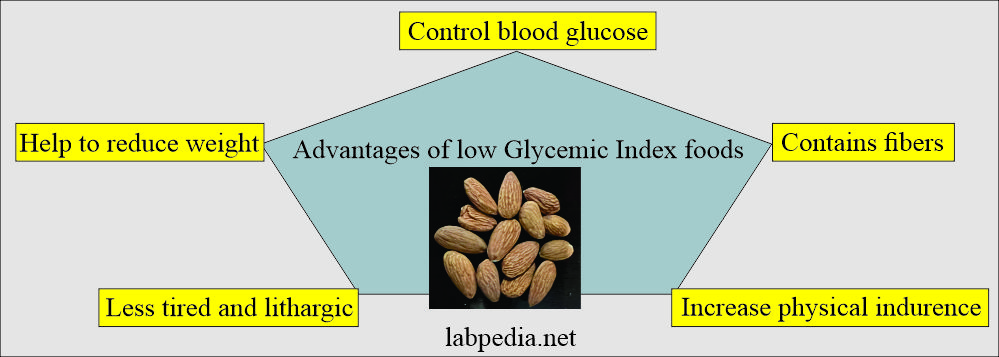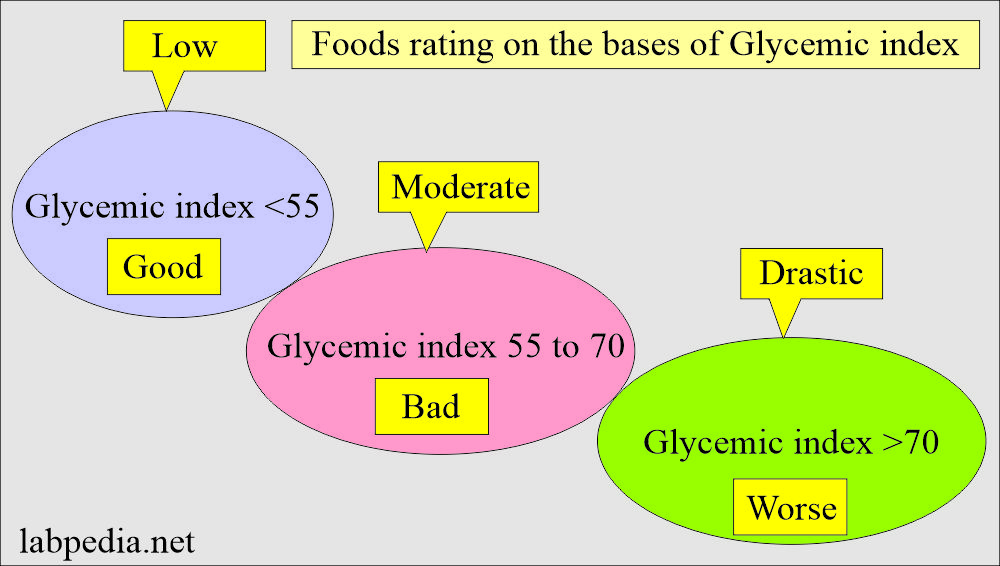Glycemic Index and Diabetes Mellitus
Glycemic Index
Definition of Glycemic Index
- Glycemic Index is defined as a system where foods are classified according to their breakdown into carbohydrates, and in turn, these split into simple sugars (Glucose) and enter the bloodstream.
- A low Glycemic Index means a smaller rise in the blood glucose level.
Benefits of a low Glycemic Index diet:
- Low Glycemic Index foods help to control the blood glucose level.
- Low Glycemic Index foods contain more fibers, so keep feeling the fullness of the stomach.
- Low Glycemic Index foods help to lose weight.
- Low Glycemic Index foods make you less tired and lethargic.
- Low Glycemic Index foods increase physical endurance.
- Reduce insulin level.
- Lower cholesterol level.
- It helps to control appetite.
- It lowers the risk of heart disease and diabetes mellitus.
Healthy diet principles:
- Try to eat different groups of foods. Try to maintain a balance in different groups of foods.
- Try to eat regularly at the same time and never miss a meal.
- Try to eat more fruits and vegetables, at least 4 to 5 portion/day.
- Try to choose a high-fiber diet and whole wheat products.
- Try to eat fish 3 to 4 times/week.
- Try to use healthy fats like:
- Avocado.
- Olives and olive oil.
- Raw nuts.
- Raw seeds.
- Lean white meat.
- Beans.
- Chickens.
- Following the above rules will give your body all essential nutrients like proteins, vitamins, fats, fibers, and minerals.
Importance of carbohydrates:
- Carbohydrates are a vital source of energy for our body and are found in all plants and foods like fruits, vegetables, grains, and cereals.
- Carbohydrates are converted into glucose, and that is the source of energy for:
- Universal fuel for our body cells.
- This is the sole energy source for RBCs.
- This is the source of the brain and fetus.
- It is the source of energy for our body muscles, especially during exercise.
- Do not ignore complex carbohydrates. Always think about a low Glycemic index diet. Also, keep attention to high glycemic index carbohydrates.
Glycemic index rating:
- The glycemic index rates carbohydrates foods from 0 to 100, depending on the rise in blood sugar (Glucose) level.
- Rise in the blood sugars graded into:
- The dramatic rise in glucose level.
- A moderate rise in glucose level.
- Low rise in glucose level.
- One should aim at the low glycemic index diet.
- These foods are classified on the basis of glycemic index as follows:
- Foods that take longer to absorb are rated as <55.
- Foods that take a moderate amount of time to be absorbed are rated as 55 to 70.
- Foods that are quickly absorbed are rated >70.
- We will see the list of these three groups of foods.
- The group is worse foods are quickly absorbed and may give rise to a spike in the glucose in the blood.
- We should try limiting foods with a glycemic index of <50.
The glycemic index (GI) of good foods (GI <55):
| Foods | Glycemic index | Foods | Glycemic index |
| Vegetables | Fruits | ||
| Lettuce | 10 | Apple | 38 |
| Broccoli | 10 | Oranges | 44 |
| Cabbage | 10 | Grapes | 46 |
| Mushrooms | 10 | Banana | 54 |
| Green peas | 48 | Peaches | 42 |
| Raw carrot | 49 | Strawberries | 40 |
| Sweet potato | 54 | Pears | 37 |
| Bread | Grapefruit | 25 | |
| Mix grain bread | 48 | Cherries | 22 |
| German rye bread | 50 | Plums | 39 |
| Grains | Tomatoes | 15 | |
| Brown basmati rice | 52 | Kiwifruit | 53 |
| Rye | 34 | Dried apricots | 31 |
| Pearl barley | 31 | Pineapple juice | 46 |
The glycemic index (GI) of bad foods (GI 55 to 70):
| Foods | The glycemic index (GI) | Foods | The glycemic index (GI) |
| Vegetables | Fruits | ||
| Potato | 57 | Pine apple | 66 |
| Corn | 55 | Mangoes | 56 |
| Beet | 64 | Golden raisin | 56 |
| Boiled mashed potato | 70 | Raisin | 64 |
| Bread | Apricot | 57 | |
| White pita bread | Miscellaneous | ||
| hamburger buns | 61 | Ice cream | 61 |
| Whole wheat bread | 69 | Honey | 58 |
| High-fiber wheat bread | 68 | Oatmeal | 55 |
| Rye flour bread | 64 | Shortbread | 64 |
| Pasta | 55 | Muffins | 62 |
| Grains | Croissant | 67 | |
| Brown rice | 55 | Pastry | 59 |
| White basmati rice | 58 | Granola cereals | 56 |
| Wheat | 55 | Porridge | 61 |
| Oatmeal | Wheat biscuits | 70 | |
| Bran cereal | Digestive biscuits | 59 | |
| White granulated sugars | 64 | ||
| Fizzy orange | 68 | ||
| Orange juice (Fruit 10% to 15%) | 66 | ||
The glycemic index (GI) of worse foods (GI >70):
| Foods | The glycemic index | Foods | The glycemic index |
| Vegetables | Fruits | ||
| French fries | 75 | Watermelon | 72 |
| Pumpkin | 75 | Miscellaneous | |
| Baked potato | 85 | Corn flakes | 83 |
| Cooked carrot | 85 | Cripsed rice | 82 |
| Rutabaga | 72 | Bran flakes with dried fruits | 71 |
| Bread | Doughnuts | 76 | |
| White bagels | 72 | Waffles | 76 |
| White wheat bread | 78 | High-glucose sports drink | 95 |
| French banquette | 95 | Fava beans | 79 |
| Gluten-free bread | 90 | Corn tortillas | 74 |
| Grain | Dates | 99 | |
| White rice | 88 | Rice cakes | 77 |
How to start a Low glycemic index diet:
- When you start a low glycemic diet, start with the following:
- Eat more vegetables and fruits. Try to use legumes and whole-grain products, like barley and oats.
- Pay attention to the bread and cereals glycemic index. American diets have mostly high glycemic index.
- Try to minimize refined flour products and starches like pastries, cakes, cookies, rolls, and crackers. Do not consider their fat contents and sugar contents.
- Avoid high glycemic foods like pretzels, rice crackers, crackers, and corn chips.
- Always check the glycemic index of the things you are eating.
- You may find that most of the common brand cereals may have a high glycemic index of >70.
- Always try to find low glycemic index (GI) bread.
- Eat fruits as snacks and drink low-fat milk and low-fat yogurt.
Summary of the foods according to the glycemic index:
| The low glycemic index foods (<55) | Medium glycemic index foods (55 to 69) | High glycemic index foods (>70) |
| Vegetables | Vegetables | Vegetables |
| Baked beans | Beets | Baked potatoes |
| Sweet potatoes | New potatoes | Mashed potatoes |
| Sweet corn | French fries | |
| Fruits | Fruits | Fruits |
| Apples | Mangoes | Watermelon |
| Pearsa | Cantaloup | |
| Peaches | Canned apricot | |
| oranges | ||
| Banana | ||
| Banana | ||
| Cereals/Grains | Cereals/Grains | Cereals/Grains |
| Pasta | Basmati rice | Jasmine rice |
| Noodles | Couscous | Corn flakes |
| Bread | Bread | Bread |
| Fruit bread | Croissant | White bread |
| Whole-grain bread | Pita bread | Doughnuts |
| Snacks | Snacks | |
| Nuts | Potato chips | |
| Chocolates | ||
| Drinks | Drinks | |
| Milk | Beers | |
| Flavored milk | Soft drinks | |
| Juices | ||
| Ice cream | ||
| Yogurt | ||
| Custard | ||
| Sugars | Sugars | Sugars |
| Maple syrup | Sugars | Glucose |
| Pure honey |



